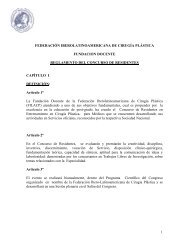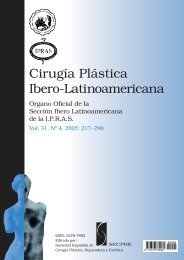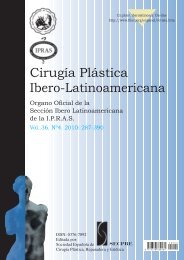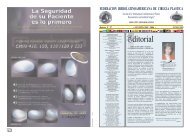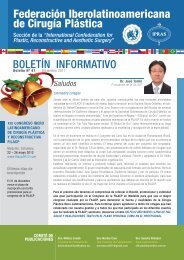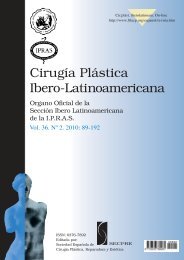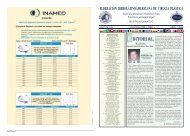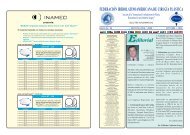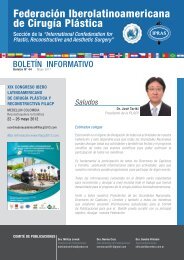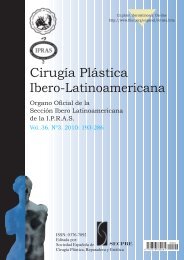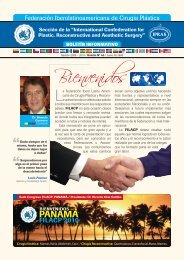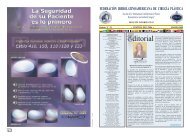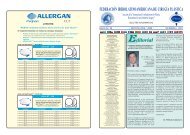Volumen 37 No. 4 - Planetec
Volumen 37 No. 4 - Planetec
Volumen 37 No. 4 - Planetec
Create successful ePaper yourself
Turn your PDF publications into a flip-book with our unique Google optimized e-Paper software.
CIRUGÍA PLÁSTICA IBERO-LATINOAMERICANA<br />
Cir.plást. iberolatinoam.-Vol. <strong>37</strong> - Nº 4<br />
Octubre -<strong>No</strong>viembre-Diciembre 2011 / Pag. 387- 392<br />
Ventajas de la cicatrización cutánea<br />
asistida por láser (LASH)<br />
Advantages of laser assisted scar healing (LASH)<br />
Mordon, S.*, Trelles, M.A.**<br />
Mordon, S.<br />
Resumen<br />
La fase final de toda cirugía es la sutura y su cicatriz correspondiente<br />
y, frecuentemente, ésta es la única secuela visible de<br />
una intervención. La técnica LASH (cicatrización cutánea asistida<br />
por láser), estimula los mecanismos de reparación de la piel por<br />
efecto térmico, condicionando la calidad de la cicatrización.<br />
Estudios experimentales en ratones comparando los resultados<br />
obtenidos en heridas quirúrgicas radiadas con laser diodo<br />
810 nm tras ser suturadas, con los obtenidos en igual tipo de heridas<br />
suturadas de manera convencional, han demostrado que se<br />
consiguen cicatrices mucho menos visibles cuando se practica el<br />
tratamiento con láser.<br />
La histología confirma, comparativamente, una notable aceleración<br />
del proceso cicatricial con modificación del TGFß (Transforming<br />
Growth Factor-Beta) directamente implicado en la<br />
reparación tisular, en los animales en los que la sutura fue asistida<br />
por láser. Igualmente, el análisis tensiométrico demostró mayor<br />
resistencia a la acción de estiramiento mecánico en estas heridas.<br />
Estudios clínicos en pacientes sometidos a dermolipectomia,<br />
reducción mamaria y estiramiento facial, demuestran que al tratar<br />
con LASH una parte o una de las líneas de sutura, los análisis<br />
realizados tanto por los pacientes como por cirujanos independientes<br />
a los 8 días, 3 meses y un año, evidencian resultados más<br />
favorables para la técnica láser, Las dosis eficaces determinadas<br />
para las fluencias láser están entre 80 y 120 J/cm 2 .<br />
La técnica LASH es simple de efectuar, reproducible, rápida y<br />
ofrece una clara evidencia de que es posible reducir considerablemente<br />
la cicatriz, logrando que ésta sea de mejor calidad y más<br />
estética.<br />
Abstract<br />
Suture is the final stage of surgery and as a consequence, a<br />
scar is frequently the only visible effect after an operation. LASH<br />
technique ( Laser Assisted Scar Healing) produces thermal effects<br />
to stimulate mechanisms for tissue repair that will determine the<br />
quality of the scar.<br />
In the experimental phase, rats were irradiated with 810 nm<br />
diode-laser after surgical wounds were sutured, and then, compared<br />
to another group of rats with the same type of wounds which<br />
were sutured with conventional techniques. The results were that<br />
those rats treated with laser had less visible scars.<br />
Histology comparatively confirmed a notable acceleration in<br />
the scarring process with modification of the TGFß (Transforming<br />
Growth Factor-Beta), which is directly involved in tissue repair in<br />
those rats treated with laser. The tensiometric analysis also demonstrated<br />
a better resistance to mechanical stress of wounds.<br />
Clinically, in dermolipectomy patients, breast reductions and<br />
facial lifts, in which part of the sutures were treated with LASH,<br />
at 8 days, 3 months and 1 year controls, evaluated by independent<br />
surgeons to the study and by patients, statistical results were more<br />
favourable for patients treated with LASH technique. The effective<br />
doses determined for treatment were laser fluencies between<br />
80 and 120 J/cm 2 .<br />
LASH is a fast, simple to carry out and reproducible method,<br />
with clear evidence that it is possible to considerably reduce scars,<br />
giving them a better quality and aesthetic appearance.<br />
Palabras clave<br />
Cicatrización, Láser.<br />
Cicatrización asistida, LASH.<br />
Key words<br />
Scar, Laser,<br />
Assisted wound healing, LASH.<br />
Código numérico 153-1545<br />
Numeral Code 153-1545<br />
* Profesor de Biofísica Médica, Doctor en Ciencias Físicas, Universidad de Lille <strong>No</strong>rd de France, Lille University Hospital, Lille, Francia.<br />
** Cirujano Plástico-Estético. Instituto Médico Vilafortuny, Cambrils (Tarragona), España



